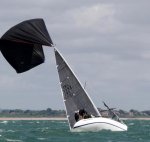mrming
Well-known member
Skippering on a corporate gig yesterday, and 'we' managed a complete wipe out, so I've been googling around to learn from my mistakes. It was identical to flaming's video from last year, full kite in the water etc.
1. Don't go for the kite just because other boats have, there were others that hadn't too!
2. Don't go in front of the helm to help out, leaving a (very experienced) dinghy sailor alone to steer
While on our side, we did manage to ease, not let go of, sheet guy and halyard to get back up right, then it was just a load of effort to retrieve everything - nobody got hurt, nothing got damaged.
My biggest concern was that having the main gybe because we sailed to deep (to avoid another boat broaching) I wanted to gybe it back to drop the kite through the letter box, but the helm simply couldn't get the boat the stern through the wind, which is when we went the whole distance.
So my question is - once you've accidentally or 'chinese' gybed, is it possible to gybe the main back, or do you just prepare for the the inevitable and deal with it.
If it was exactly like Flaming's video, you're never going to gybe the main back until you get the kite down and get the boat back on it's feet as you'll have lost all rudder authority by that point. All the tips on how to avoid it happening in the first place are very well covered in this thread, but once it's happened it's really just about making sure everyone's okay and then slowly undoing the mess which it sounds like you did well.
Edit - just realised it sounds like you couldn't get the boat to gybe back before you actually wiped out. A kite in heavy weather that hasn't been flattened, tweaked down and over sheeted etc will tend make the boat's nose dip. Having crew then run forward may have completed the job of breaking the rudder out and causing it to lose grip. On many boats you see nearly all the crew standing at the back in heavy airs downwind for that reason.
Last edited:

